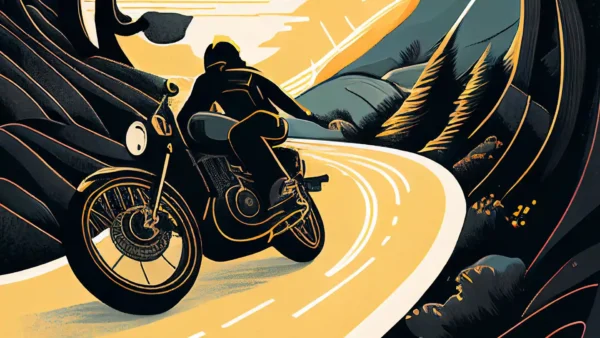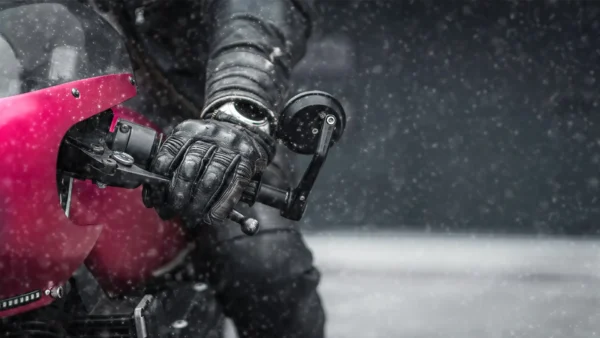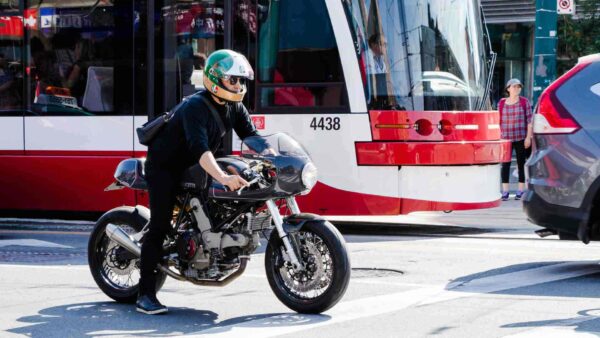Riding a motorcycle should be fun, but there are some common sense things you can do to keep yourself safer out on the roads. Pick a bike you can handle, always wear a helmet, make yourself visible, leave lots of space, and be alert and aware of your surroundings. Motorcycle insurance rates can vary depending on your riding record and the size and power of your bike.
Motorcycle riders like to say “Four wheels move the body; two wheels move the soul.” This is true for anyone who takes to the open road on two wheels. There is nothing like cruising on the open road, feeling the rumble of the bike, and enjoying a beautiful summer day.
But before you take to that road, there are some other things to consider. For one thing, although Canadians can only ride for maybe 6-8 months of the year, motorcycle insurance can be as expensive, or more expensive, than car insurance. The simple reason is that it is much riskier to ride a motorcycle than it is to drive a car or truck. The vehicle may cost less, but that has almost no bearing on the likelihood of an accident, which is much greater in the case of a motorcycle.
This doesn’t have to ruin your fun. It is possible for most Ontarians to get the motorcycle insurance they need at a price they can afford. For those who can’t right now, it’s usually a matter of building up enough experience.
So how are motorcycle insurance rates calculated, what does the insurance cover, and what else do you need to know to make your riding safe, enjoyable, and as affordable as possible?
Riding season
In Ontario, motorcycle insurers break down the cost of your insurance policy based on the time that most people ride (March to October). Your insurer knows that most people do not ride in the winter, and almost all claims happen in the months that riders are out on the road. (If you bought a policy in the spring, you are covered to ride through the winter, but it may not be the safest thing to do.)
So, you pay most of your premiums for the summer months, a little for the spring and fall, and nothing for the winter months.
If insurers made every month cost the same, a lot of people would cancel in the fall and start a new policy in the spring. But there are reasons to keep your bike insured in the winter (theft and other damages) and for you, there would be additional costs to process all those cancellations and new policies, which would increase the total annual cost of a policy. So, since the cost comes from the losses that happen in the riding season, the insurance company essentially “adds” the winter months “for free” to make renewal easier and cheaper.
Insurance rates and motorcycle sizes
Generally, the smaller, less expensive motorcycles cost less to insure. The trick, of course, is to find a ride that has enough power to match your skills, that is physically big enough for your size, and that does not cost too much to insure. You also want to find a motorcycle that, hopefully, you will not outgrow in one season.
Remember, it is going to cost more to insure a powerful bike with lots of features. A 250cc Honda will cost a lot less than a 1600cc fully stocked Harley.
Do your research. Rider training course instructors are a wealth of information for you in suggesting models that will fit your size and skill, and so are motorcycle dealers.
And before you buy, check with your Mitch broker for specific quotes for the bike you plan on buying. The actual bike you buy makes a big difference in the rate you pay, and you do not want any surprises after you purchase it.
What are you insured for?
Like auto insurance, motorcycle insurance is required by law in Ontario. The mandatory minimum coverage includes the following:
- Third-party liability: Protects you if you kill or injure another person in an accident or if you damage another person’s property. $1or 2 million is recommended.
- Statutory accident benefits: Provides you with medical, rehabilitation, and death benefits in case you are killed or injured in an accident, no matter who caused it.
- Direct compensation property damage (DCPD): Pays to repair your motorcycle if another driver/rider is at fault for the accident or if the other driver/rider is insured somewhere other than Ontario.
- Uninsured automobile coverage: Provides you with coverage if you are injured or killed in an accident involving an unidentified or uninsured driver.
Your policy can also include optional collision, fire and theft coverage. You can even get coverage for your electronics and accessories (GPS devices, saddlebags, etc.)
Just a note but in most cases, a few extra pieces of chrome or amendments to your bike make no difference to either the insurability of your bike or the cost of your motorcycle insurance. Switching your exhaust, for example, should be a non-issue. However, different insurance companies have different rules and guidelines, so it is best to check with your broker to make sure you are still properly insured for the value of your bike.
You can also customize your policy to your specific habits. For example, if you like going off-road, you can purchase additional peril coverage that insures your motorcycle against damages that may occur when you ride in those conditions. Talk to your broker about all your riding habits and plans for your bike.
Motorcycle rider ratings
Just like auto insurance, motorcycle rates are calculated using factors like these:
- Your age and gender. Younger males pay more for motorcycle insurance. A 20-year-old male will pay significantly more than a 50-year-old female because past experience shows that this type of rider is more likely to crash, get injured, and make claims.
- Your license levels. We discuss this in the next section.
- Your riding experience. Again, the data collected by insurance companies over years and years clearly shows that experienced riders are much less likely to make claims than newer riders. Likewise, riders that have tickets or accidents on their records pay more for the same reason.
- The make and model of your motorcycle. Larger and more powerful bikes will cost more to insure, especially for newer riders.
Motorcycle licensing
Your insurance will also reflect your licensing status. Just like driving a car in Ontario, there is a graduated system for motorcycle licensing in the province. After you pass your eye and written tests, you get an M1 license. Before you get a full M license, you must finish two learning levels:
- M1 and M2 (for full-speed motorcycles)
- M1 and M2-L (for mopeds and motorized scooters)
- M1 and M2-M (for three-wheeled motorcycles)
Also, you need to pass a road test for both the M2 and full M licenses. Once you get your M2 license, you have up to five years to finish the learning process. After five years, if you do not get your full license, you will need to start over.
Insurers consider you a novice rider until you have an M license. If you hold one of the learner’s licenses listed above, you are still learning to ride and gaining important experience.
Restricted-speed motorcycles — also known as mopeds — are bikes that cannot exceed 70 km/h and have an engine size of 50cc or less. They require the same insurance as a full-size motorcycle, and you need a restricted class M license (or a full motorcycle license) to ride them.
Safety on the roads
Always do a safety check of your motorcycle before you ride. If it is your first ride of the season, do a complete check of your motorcycle or take it to a dealer for a tune-up. At the very least, check and clean your battery terminals and check the oil and other lubricants. Also, check the tire inflation and inspect your tires for cuts and cracks. Five minutes of prevention can go a long way to a safe ride.
Other helpful tips include:
- Ride according to weather and road conditions. Check the forecast and keep your eyes on the road ahead.
- Get professional training. Benefit from riding courses to sharpen your skills and learn the latest techniques.
- Maintain your bike. Have it regularly maintained by a good mechanic and check it yourself before and after each ride.
- Dress for the fall, not the ride. The proper gear – which includes an approved safety helmet, eye protection, a motorcycle jacket, motorcycle pants, gloves and over-the-ankle boots – may reduce your risk of serious injury. Shorts and T-shirts are not proper riding attire.
- Wear a DOT approved helmet. Choose the helmet best suited for how you ride and replace your helmet every five years.
- Wear bright colours or reflective material to make you more visible to motorists.
- Stay sharp. Keep your eyes moving and do frequent shoulder checks.
- Scan the road surface ahead of you. Watch for road surface irregularities such as railroad tracks and potholes. Also, avoid gravel, oil, mud, water, wet leaves and rocks that can cause your motorcycle to slide or bounce over.
- Mind the gap. Leave an adequate gap between you and the car in front of you. On open roads with higher speeds, adjust your gap.
- Be seen. Always signal lane changes and position yourself where others on the road can easily see you. Make eye contact with motorists when possible. Many riders claim they “just didn’t see” a motorcycle after colliding with it.
- Always have a way out. Identify potential hazards as you ride. Predict the worst-case scenario and prepare an escape route.
- Ride what you can control. Often, people buy motorcycles that are too powerful for them to handle. Ask your dealer if you can test ride the bike before you buy it.
We hope that the information and tips provided will be helpful for you as you search for a motorcycle insurance policy to protect your favourite ride. Your friendly Mitch broker will be happy to help you and answer all your questions.
See you out on the road!
Looking for motorcycle insurance?
Speak with a Mitch Insurance broker today to get a quote on Ontario motorcycle insurance.
Call now
1-800-731-2228








Not going to pay $900 to drive 20 miles. I might pay $450, but certainly not “DOUBLE” Best of luck people !